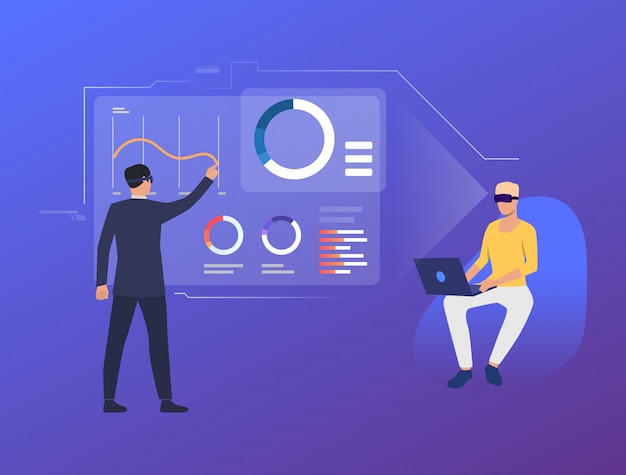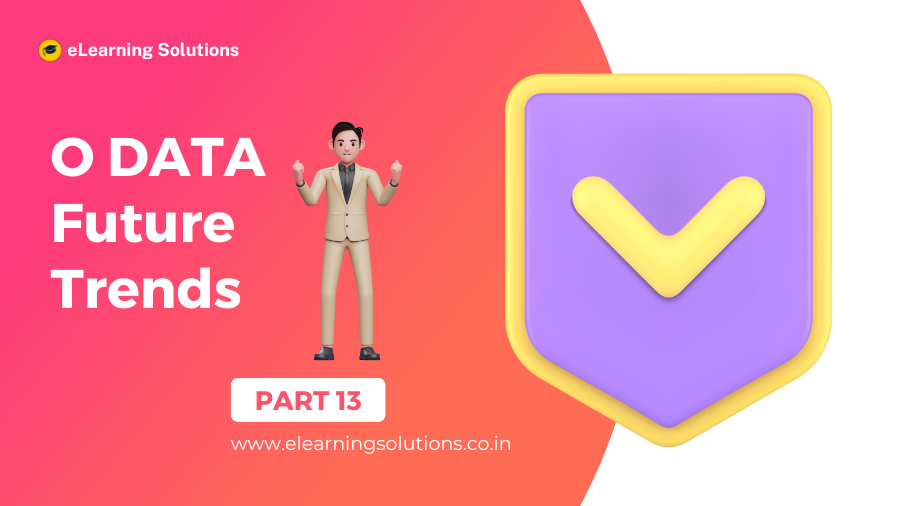In the ever-evolving landscape of data management and integration, O DATA continues to play a crucial role in enabling seamless communication and interoperability between diverse systems. As technology advances and new challenges arise, O DATA is expected to embrace innovative trends that will shape its future. In this article, we will explore the emerging trends of O DATA and its potential impact on various aspects of data-driven applications and services.
1. O DATA in the Age of Big Data and AI

The proliferation of data from various sources, often referred to as Big Data, has presented both opportunities and challenges for organizations. O DATA, with its scalable and flexible architecture, is well-positioned to thrive in the era of Big Data. As datasets grow larger and more complex, O DATA can handle the massive volume of data, enabling efficient data retrieval, querying, and manipulation.
Moreover, the integration of O DATA with Artificial Intelligence (AI) and Machine Learning (ML) technologies is set to unlock new possibilities. AI-powered applications can leverage O DATA’s rich query capabilities to extract valuable insights from vast datasets. O DATA’s support for data aggregation, filtering, and sorting can facilitate AI algorithms in making data-driven decisions, automating processes, and enhancing overall system intelligence.
2. O DATA in Web Services and Microservices Architectures

Web services and microservices architectures have become increasingly popular in modern software development. These architectural paradigms promote modularity, flexibility, and scalability in application design. O DATA aligns seamlessly with these approaches, providing a standardized way to expose data and functionalities through APIs.
In a microservices-based system, O DATA can serve as a central data gateway, enabling microservices to communicate and exchange data effortlessly. Each microservice can expose its data as O DATA entities, simplifying data access for other services within the ecosystem. This integration simplifies the communication between microservices, reduces development effort, and promotes better code reusability.
For web services, O DATA offers a unified protocol for data access, reducing the complexity of integrating data from multiple sources. The standardized O DATA queries ensure that clients can retrieve the data they need efficiently, regardless of the underlying data sources or technologies used.
3. O DATA Standard Advancements Trends

O DATA is an open standard that is continually evolving to meet the needs of the modern data-driven world. As the community of developers and businesses grows, the O DATA standard is likely to see advancements in various areas, including protocol improvements, query options, and support for new data formats.
One area of advancement could be further optimization for real-time data streaming. With the increasing demand for real-time data processing in various domains, O DATA may introduce enhancements to streamline the process of streaming and querying real-time data, ensuring low-latency access to critical information.
Additionally, O DATA may explore new ways to support data synchronization and offline access, facilitating data management in disconnected or low-bandwidth scenarios. This improvement will be especially relevant for mobile applications and IoT devices where connectivity can be intermittent.
Furthermore, advancements in O DATA may address security and privacy concerns, providing robust authentication and authorization mechanisms to protect sensitive data in an increasingly interconnected world.
In conclusion, the future of O DATA is promising, and the protocol’s versatility and standardization make it well-suited to adapt to the dynamic data landscape. As the age of Big Data, AI, web services, and microservices continues to unfold, O DATA will undoubtedly play a pivotal role in shaping the way data is managed, integrated, and consumed in various applications and industries.
Bonus: 2023 Vision: Discover the SAP Jobs with High Earning Potential
PART-12 | THANK YOU FOR READING!
Find Your Preferred Courses
SAP SD (Sales and Distribution) is a module in the SAP ERP (Enterprise Resource Planning) system that handles all aspects of sales and distribution processes. S4 HANA is the latest version of SAP’s ERP suite, built on the SAP HANA in-memory database platform. It provides real-time data processing capabilities, improved…
SAP Human Capital Management (SAP HCM) is an important module in SAP. It is also known as SAP Human Resource Management System (SAP HRMS) or SAP Human Resource (HR). SAP HR software allows you to automate record-keeping processes. It is an ideal framework for the HR department to take advantage…
I am text block. Click edit button to change this text. Lorem ipsum dolor sit amet, consectetur adipiscing elit. Ut elit tellus, luctus nec ullamcorper mattis, pulvinar dapibus leo.
Salesforce Developer Training Overview Salesforce Developer training advances your skills and knowledge in building custom applications on the Salesforce platform using the programming capabilities of Apex code and the Visualforce UI framework. It covers all the fundamentals of application development through real-time projects and utilizes cases to help you clear…
SAP EWM stands for Extended Warehouse Management. It is a best-of-breed WMS Warehouse Management System product offered by SAP. It was first released in 2007 as a part of SAP SCM meaning Supply Chain Management suite, but in subsequent releases, it was offered as a stand-alone product. The latest version…
Oracle PL-SQL is actually the number one database. The demand in market is growing equally with the value of the database. It has become necessary for the Oracle PL-SQL certification to get the right job. eLearning Solutions is one of the renowned institutes for Oracle PL-SQL in Pune. We believe…
Course details for Pega Training in Pune Elearning solution is the best PEGA training institute in Pune. PEGA is one of the Business Process Management tool (BPM), its development is based on Java and OOP concepts. The PAGA technology is mainly used to improve business purposes and cost reduction. PEGA…
SAP PP Training Institute in Pune SAP PP training (Production Planning) is one of the largest functional modules in SAP. This module mainly deals with the production process like capacity planning, Master production scheduling, Material requirement planning shop floor, etc. The PP module of SAP takes care of the Master…
SAP BASIS Module Course Content (1) Hardware and Software Introduction (i) Hardware (a) Hardware Introduction (b) Architecture of different Hardware devices (ii) Software (a) Software Introduction (b) Languages and Software Development (c) Introduction to OS (d) Types of OS (iii) Database Concepts (a) Introduction (b) Database Architecture and concepts (c)…
Curriculum Details SAP HANA Administration SAP HANA Introduction SAP HANA Introduction SAP HANA Information Sources Installation Preparation SAP HANA Sizing Linux Operating system requirements SAP HANA Installation Introduction to SAP HANA Lifecycle Management tools Describing Advanced Installation options Explaining a Distributed system SAP HANA Architecture SAP HANA Architecture and Technology…
Business Warehouse (BW) is SAP’s data warehousing application; it uses an SAP NetWeaver application server, but can run on many different databases. Improvements come with each version of Courses for sap BW on HANA training, but a really big jump in functionality comes when SAP BW is installed on the…
SAP SAP HANA simple logistics is also known as HANA enterprise management. Different area of business is combined in this suit itself like HANA enterprise-management helps in faster and efficient processing of business data in the area of logistics, supply chain, procurement, user experience, sales, partner management. So Course for…
ABAP remains a key language as many SAP business applications and custom developments are written in ABAP, with Courses for sap ABAP on HANA training there are numerous improvements. The ABAP language, which allows writing streamlined ABAP code and benefit from SAP HANA. SAP HANA is a relational DBMS in SAP…
SAP HANA is the latest ERP Solution from SAP, which is a combination of Hardware and Software. HANA has unprecedented adoption by the SAP customers. courses for SAP HANA training institutes. SAP HANA is the latest, in-memory database, and platform which can be deployed on-premises or cloud. SAP HANA is a…
Oracle Applications R12 HRMS is one of the most demanded applications by most organizations. It is the core application possess by the ERP system. The core objective of the organization to implement Oracle R12 HRMS is to organize the entire activates of human resources management. An Elearning solution is well…
Elearning solutions provide training suit for Oracle Apps R12 SCM with training from industry experts. The organizations are adopting Oracle’s supply chain management cloud as they deliver the insights, visibility, and capabilities for organizations’ management. Oracle Apps R12 SCM allows the industry to create own intelligent supply chain. Hence, it…
Oracle Apps R12 Technical Course Elearning solutions is the best Oracle Apps R12 technical course in Pune owned by well trained and certified trainers. The training is conducted by the best experienced IT professionals with skilled resources. The course structure is based on the real-time scenario so that it will…

₹25,000.00
Elearning solutions is the best SAP FICO training institute in Pune. SAP FICO is the Finance and Cost controlling module is one of the most important and widely used SAP ERP modules among organizations. As it is very robust and encounter almost all the business processes. In SAP FICO, FI…
Elearning solutions provide SAP SD training. The tutorials are designed for the students who desired to understand SAP SD concepts and implement them in practice. The SAP SD training is delivered by industry experts, who are aware of the real-time scenarios. Hence, supporting students understand, what will be there on…
SAP WM training is offered by Elearning solutions provides 100% hands-on practical classes. The primary focus of training is getting placement for all the students. The tutorials are designed for the students who wished to work on live projects for the organizations. The syllabus of SAP WM training is crafted…
Elearning solutions are the best SAP MM training institute in Pune. SAP MM (material management system) is one of the important models of the SAP ERP system, which is particularly designed for business processes. SAP MM deals with the entire material and inventory management of the organization. The module is…
Elearning Solutions best SAP ABAP training institute in Pune provides real-time training for students. SAP ABAP (Advanced Business Application Programming) is a programming language for building SAP applications such as SAP R/3 which runs in the SAP ABAP runtime environment. (SAP ABAP online course) SAP ABAP is used by organizations…







 WhatsApp us
WhatsApp us